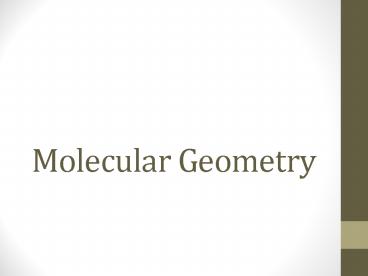Molecular Geometry - PowerPoint PPT Presentation
1 / 21
Title:
Molecular Geometry
Description:
Molecular Geometry It s all about the Electrons Electrons decide how many bonds an atom can have They also decide the overall shape of the molecule OPPOSITES ATTRACT! – PowerPoint PPT presentation
Number of Views:173
Avg rating:3.0/5.0
Title: Molecular Geometry
1
Molecular Geometry
2
Its all about the Electrons
- Electrons decide how many bonds an atom can have
- They also decide the overall shape of the
molecule - OPPOSITES ATTRACT!
3
Lewis Structures
- A Lewis structure is basically a diagram of how a
molecule looks using dots to represent the
electrons. - There are 4 rules for making these structures and
that is where the electrons come into play.
4
Rule number 1
- Count the Number of valence electrons!
- This means of all the atoms present
- With a polyatomic anion, add one for each
negative charge - With a polyatomic cation, subtract one for each
positive charge - Ex CO2
- C 4 O 6 6 6 4 16
5
Rule Number 2
- Draw a skeleton structure for the molecule
using all single bonds - This will most often be one central atom with
several surrounding ones - Typically the central atom is written first
- Ex CO2 O-C-O
6
Rule Number 3
- Determine the number of valence electrons still
available for distribution - To do this simply deduct two valence electrons
for each single bond written in step two - Ex CO2 two single bonds so far so we
subtract a total of 4 - 16 4 12
7
Fourth Rule
- Determine the number of electrons required to
fill an octet for each atom - If this equals the number of electrons left, then
place them on the atoms as unshared pairs - If the number of electrons available is less than
the number needed then you need to make double or
triple bonds in place of the single bonds
8
CO2 (again)
- O C O
- So far we have used four electrons so 16 4 12
- Carbon still needs 4 more electrons and each
Oxygen needs 6 more. 6 6 4 16 - But we only have 12 left so lets make some double
bonds! - O C O becomes O C O
9
- Now Carbon doesnt need anymore electrons and the
Oxygens only need 4 more each. Since we used 4
electrons to make those into double bonds we now
have exactly 8 electrons left. - Now we simply distribute them to the Oxygen atoms
as unshared paired electrons.
10
Practice!
11
Resonance!
- Resonance is invoked whenever a single Lewis
structure does not adequately reflect the
properties of a substance - In other words, resonance comes into play when
you can make two structures that are the same in
their placement of atoms but different in the
bonds - SO2
12
- Resonance structures are NOT forms where the
electrons move eternally between them - Resonance structures are equally plausible or
they are not a resonance structure - Resonance forms differ in their distribution of
electrons, NOT in their arrangement of atoms! - So just because a formula for a compound is the
same it does not mean that it is a resonance
structure
13
VSEPR
- Lewis structures tell us how the atoms are
connected to each other. - They dont tell us anything about shape.
- The shape of a molecule can greatly affect its
properties. - Valence Shell Electron Pair Repulsion Theory
allows us to predict geometry
14
VSEPR
- Molecules take a shape that puts electron pairs
as far away from each other as possible. - Have to draw the Lewis structure to determine
electron pairs. - bonding
- nonbonding lone pair
- Lone pair take more space.
- Multiple bonds count as one pair.
15
Electronegativity
- Electronegativity is a measure of how much an
element wants to pull electrons towards itself - This is represented as a unit-less number ranging
from 0 4.0 - Heres a handy reference sheet with all the
values. Guard it with your LIFE!
16
So what?
- These numbers can be used mathematically to know
if a bond is ionic or covalent - It can also tell you if a covalent bond is more
polar or less polar (more on polarity in a
minute) - So all we have to do is subtract one from the
other.
17
Example
- Fluorine has an electronegativity of 4.0
- Sodium has an electronegativity of 0.9
- 4.0 0.9 3.1
- So what does that mean?
- It means that it is an ionic bond!
- This makes sense since we know that a bond
involving one metal and one non-metal is ionic.
18
Example two
- Fluorine has an electronegativity of 4.0
- Carbon has an electronegativity of 2.15
- 4.0 2.5 1.5
- This makes this bond covalent!
19
Sharing is caring, but some elements are greedy!
- This greediness shown by some elements like
fluorine leads us to the next piece of this
puzzle - The more unequal the sharing of electrons is in a
bond, the more polar it is. - The smaller that difference in electronegativity,
the less polar.
20
Polar vs Non-polar
- Polar
- Number greater than 0.4
- Unequal sharing of electrons
- Water is an example
- Non-Polar
- Number less than 0.4
- Equal sharing of electrons
- Methane (CH4) is an example
21
So why is this important?
- Polarity is a major component of organic
chemistry - Polarity also explains why certain substances can
dissolve other substances while others cannot - Think oil and water































